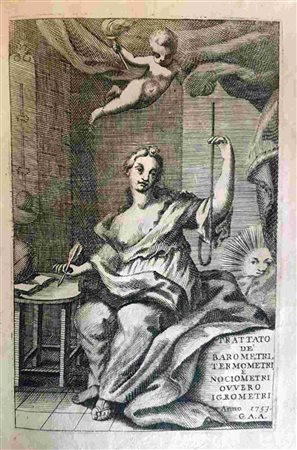 Bertolami Fine Art - Sendlinger Straße 24, 80331 Monaco
Bertolami Fine Art - Sendlinger Straße 24, 80331 Monaco
WEB AUCTION 118 - LIBRI E AUTOGRAFI WEB AUCTION 118 - LIBRI E AUTOGRAFI
giovedì 16 giugno 2022 ore 14:00 (UTC +01:00)
JOACHIM D’ALENCÉ (?-1707): Trattato curioso di matematica nel quale col mezzo di tre instrumenti cioé del barometro, termometro ed igrometro, si può conoscere, misurare il peso, la leggerezza, il ca
Joachim D’Alencé (?-1707)
Trattato curioso di matematica nel quale col mezzo di tre instrumenti cioé del barometro, termometro ed igrometro, si può conoscere, misurare il peso, la leggerezza, il caldo, il freddo, la secchezza e l'umidità dell'aria.. In Venezia, appresso Gio. Battista Recurti, 1753
First Italian edition of a work first published in French in 1668, with some additions “There are added some problems of mathematical physics and some memories extracted from Bernoulli, La Hire and Cassini” (Riccardi. translated).
The present work met with an immediate success.Its scientific merits consist in the improvement in the construction of both barometers and thermometers: “His detailed description of the principal meteorological instruments of the period is enriched with several new ideas...” (Taton). As far as barometers are concerned, Dalencé was the first one to point out that certain varieties of wood possess the property of being pervious to air, but impervious to mercury, observation that allowed the construction of portable cistern barometers, which may also be placed in any position if the cistern is spherical and more than half-full of mercury, the tube ending at its center..His most durable contribution to instrument making consists however in his proposition of the first workable scale for the measurement of temperatures, taking as extremes the freezing point of water in winter and the melting point of butter in summer. This constituted a significant progress over the previous scales, as e. g. that proposed by Fabri, which used snow and the greatest summer heat as extreme points. Ref: Riccardi, I (2), 556; for ader editions: Daumal A history of scientific instruments p. 57; Bierens de Haan, n. 1065; cfr. R.Taton DSB III, 534; W. E. Knowles Middleton A history of the barometer pp. 145-147 and passim.


